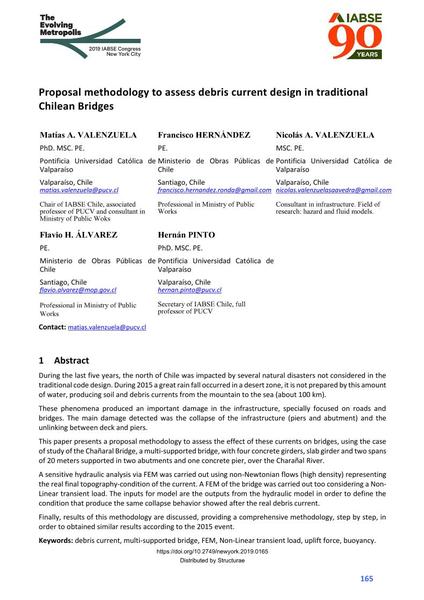Proposal methodology to assess debris current design in traditional Chilean Bridges

|
|
|||||||||||
Bibliographic Details
| Author(s): |
Matías A. Valenzuela
(Pontificia Universidad Católica de Valparaíso)
Francisco Hernandez (Ministerio de Obras Públicas de Chile) Nicolás A. Valenzuela (Pontificia Universidad Católica de Valparaíso) Flavio H. Álvarez (Ministerio de Obras Públicas de Chile) Hernan Pinto (Pontificia Universidad Católica de Valparaíso) |
||||
|---|---|---|---|---|---|
| Medium: | conference paper | ||||
| Language(s): | English | ||||
| Conference: | IABSE Congress: The Evolving Metropolis, New York, NY, USA, 4-6 September 2019 | ||||
| Published in: | The Evolving Metropolis | ||||
|
|||||
| Page(s): | 165-169 | ||||
| Total no. of pages: | 5 | ||||
| DOI: | 10.2749/newyork.2019.0165 | ||||
| Abstract: |
During the last five years, the north of Chile was impacted by several natural disasters not considered in the traditional code design. During 2015 a great rain fall occurred in a desert zone, it is not prepared by this amount of water, producing soil and debris currents from the mountain to the sea (about 100 km). These phenomena produced an important damage in the infrastructure, specially focused on roads and bridges. The main damage detected was the collapse of the infrastructure (piers and abutment) and the unlinking between deck and piers. This paper presents a proposal methodology to assess the effect of these currents on bridges, using the case of study of the Chañaral Bridge, a multi-supported bridge, with four concrete girders, slab girder and two spans of 20 meters supported in two abutments and one concrete pier, over the Charañal River. A sensitive hydraulic analysis via FEM was carried out using non-Newtonian flows (high density) representing the real final topography-condition of the current. A FEM of the bridge was carried out too considering a Non- Linear transient load. The inputs for model are the outputs from the hydraulic model in order to define the condition that produce the same collapse behavior showed after the real debris current. Finally, results of this methodology are discussed, providing a comprehensive methodology, step by step, in order to obtained similar results according to the 2015 event. |
||||
| Keywords: |
FEM buoyancy debris current multi-supported bridge non-linear transient load uplift force
|
||||
